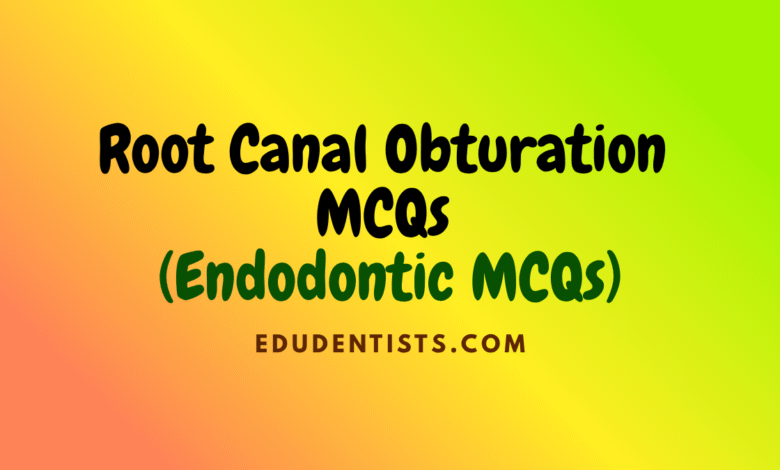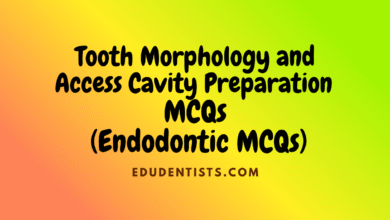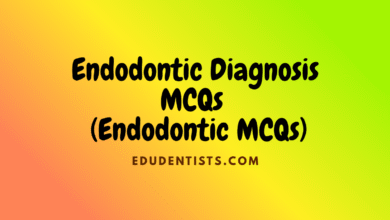Root Canal Obturation MCQs (Endodontic MCQs)
Root Canal Obturation MCQs _ Endodontic MCQs

Root Canal Obturation MCQs _ Endodontic MCQs
Root Canal Obturation MCQs _ Endodontic MCQs
1. All of the following are radiographic criteria for assessing obturation except one. Which is the exception:
A) Length
B) Taper
C) Density
D) Apical seal
E) Adequate provisional restoration
2. A hermetic seal is best described as:
A) An airtight seal
B) A fluid-tight seal
C) A fluid-tight seal that permits the passage of air
D) A seal that prevents bacterial penetration
E) A seal that prevents leakage of bacteria and their byproducts
3. Which of the following statements about the timing of obturation is correct:
A) Obturation of cases with pulp necrosis and acute apical abscess is best accomplished at the initial appointment.
B) Cases of irreversible pulpitis obturated at the initial visit have the best prognosis.
C) Cases involving necrosis are best treated in two visits, because the incidence of postoperative pain is higher than with single-visit treatment.
D) Obturation of cases involving pulp necrosis and chronic apical periodontitis can be done in one visit provided antibiotics are prescribed to eliminate residual bacteria.
4. All of the following are advantages of completing root canal treatment in one visit except one. Which is the exception:
A) Recontamination of the canal from coronal leakage is prevented.
B) The definitive restoration can be placed.
C) Management of continued postoperative problems is facilitated.
D) Patient compliance is not a factor in the treatment and the cost of providing treatment is reduced.
5. Obturation should be done:
A) To the radiographic apex
B) At the cementodentinal junction
C) At the major diameter of the foramen
D) At the minor diameter of the constriction
6. Which of the following statements about accessory canals is correct:
A) They are effectively cleaned by sodium hypochlorite in concentrations exceeding
B) They play a major role in periradicular pathosis.
C) They have a consistent pattern of appearing on either the mesial or the distal surfaces.
D) They are uncommon, and a root seldom has more than one.
E) They are serendipitously identified on postoperative radiographs.
7. Which of the following has a significant negative effect on the long-term prognosis after obturation:
A) Obturation of vital cases 1 to 3mm short of the radiographic apex.
B) Obturation of necrotic cases 0 to 2mm short of the radiographic apex.
C) Extrusion of obturating materials.
D) Obturation at the time of cleaning and shaping.
8. Which of the following statements about the smear layer is correct:
A) It is a thick layer of inorganic debris on the canal wall that remains after cleaning and shaping.
B) It provides a complete barrier to bacterial invasion of the tubules.
C) It contains organic debris that might serve as a substrate for bacterial growth.
D) It forms when the pulp is necrotic and devoid of structure rather than in vital cases, in which the pulp is easily removed.
9. MTAD:
A) Contains an analog of tetracycline, an acid, and detergent.
B) Is composed of 17 citric acid.
C) Unlike EDTA has no antimicrobial activity.
D) Has been advocated as a replacement for sodium hypochlorite because of its low toxicity.
E) Removes organic components of the smear layer but is ineffective at removing inorganic material.
10. Calcium hydroxide sealers:
A) Have been shown to induce apical hard-tissue formation.
B) Are antimicrobial and kill residual bacteria.
C) May be zinc oxideeugenol or catalyst-resin based.
D) Bond to dentin but release formaldehyde upon setting.
11. Medicated sealers with paraformaldehyde:
A) Are acceptable provided appropriate cleaning and shaping procedures are performed.
B) Are resin based and have minimal toxicity.
C) Should be used only in vital cases in which mummification of tissue is desirable.
D) Produce paresthesia (which is reversible with time) when extruded.
E) Do not meet the standard of care.
12. All of the following statements about gutta-percha are correct except one. Which is the exception:
A) Gutta-percha cones are composed of 60 gutta-percha, 20 zinc oxide, 10 radiopacifiers, and 5 plasticizers.
B) Standardized cones seldom have uniform dimensions.
C) When heated, gutta-percha becomes pliable.
D) The alpha and beta forms have the same mechanical properties.
E) Shrinkage occurs when gutta-percha is in the beta form.
13. Sterilization of gutta-percha is best accomplished by:
A) Autoclave.
B) Immersing the cones in 5.25 sodium hypochlorite for 1 minute.
C) Cold sterilization with 2 glutaraldehyde.
D) Wiping the cones with 70 ethyl alcohol.
E) Wiping the cones with 2 chlorhexidine.
14. Resilon is:
A) A resin core alternative to gutta-percha.
B) Nontoxic but has mutagenic properties.
C) A material with cross latex allergenicity.
D) A material that requires a light cure to set.
E) Not compatible with thermoplasticized injection.
15. A proposed advantage of the Monoblock:
A) Bonding to the smear layer occurs.
B) Sodium hypochlorite enhances the attachment to dentin.
C) A core obturation material is not necessary.
D) The core-sealer interface is eliminated.
16. All of the following statements about custom cones are correct except one. Which is the exception:
A) The seal may be improved.
B) The master cone adapts to the canal, preventing extrusion.
C) The cone is placed in solvent until the external surface has softened.
D) The primary purpose is length control during compaction procedures.
E) Fabrication requires fitting the cone to length with tugback before softening.
17. A major advantage of lateral compaction is:
A) Lamination of the accessory cones during compaction.
B) The ability to fill canal irregularities.
C) The ability to adapt master cones to fit the apical morphology.
D) Length control.
18. Which of the following statements about the use of heat in warm vertical compaction is correct:
A) The temperature of the external surface of the root must not rise more than 10C.
B) The temperature of the internal canal wall surface must not increase more than 10C.
C) System B and the Touch N Heat pose an equally greater risk of injury to the periodontium.
D) Ultrasonic warm lateral compaction does not pose a risk of damage to the periodontium.
E) With Resilon, heat should be used only to sear the excess material at the orifice because the setting reaction of this material is exothermic.
19. All of the following statements about continuous wave compaction are correct except one. Which is the exception:
A) Pluggers are used that fit to within 5 to 7mm of the corrected working length.
B) Heat is applied to the plugger, which is moved quickly to the binding point; hydraulic pressure then is applied without heat for 5 to 10 seconds.
C) The technique cannot be used in oval canals because of the inability to develop hydraulic pressure.
D) The pluggers have a uniform taper of size .06 but have variable tip diameters.
E) Standardized size .02 tapered gutta-percha cones fit with tugback are preferred.
20. The Obtura II differs from the UltraFil in that:
A) Obtura II cannules can be heat sterilized.
B) Resilon cannot be used with the Obtura II but can be used with the UltraFil.
C) The Obtura II heats gutta-percha to a higher temperature.
D) The Obtura II requires a more tapered canal preparation.
E) UltraFil produces greater compaction of lateral canals.
21. All of the following statements about ThermaFil obturation are correct except one. Which is the exception:
A) Size verifiers are available to help determine the appropriate carrier.
B) Calibration rings on the carrier assist in placement of the carrier to length.
C) The carrier is inserted without rotation.
D) Preppi burs are specifically designed for sectioning the carrier at the canal orifice.
E) Although AH26 is a recommended resin sealer, Tubli-Seal and Wachs paste are acceptable zinc oxideeugenol formulations.
22. The SimpliFill obturation system:
A) Consists of a plastic carrier upon which gutta-percha is fused.
B) Requires passive fitting of the carrier to length before backfilling with lateral compaction.
C) Is designed for obturation of canals prepared with LightSpeed instruments.
D) Requires coating of the carrier with gutta-percha expressed from a syringe.
E) Should not be used in teeth that will require a post for retention of the crown.
23. Each of the following has been advocated as an apical barrier material. Which is preferable:
A) Calcium hydroxide
B) Dentin chips
C) Collagen
D) Mineral trioxide aggregate.
E) Tricalcium phosphate
24. Which following methods would be best for reducing coronal microleakage in posterior teeth:
A) Heating the coronal gutta-percha and vertically compacting the material.
B) Bonding a resin-modified glass ionomer cement over the pulpal floor.
C) Obturating the coronal 2 to 3mm with thermoplastic injection of gutta-percha.
D) Leaving a layer of gutta-percha covering the chamber floor.





